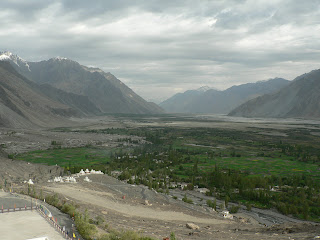The Tibetan
Empire was bigger than you thought! Come visit Western Tibet.
Dr Seow Onn Choong
Recently an old classmate traveled to Tibet. He sent his itinerary
to me with photos of the places he had visited. I have not been to Tibet before
but there is a placed I visited that look very similar.
Have You Heard of Western Tibet?.
All of us know Tibet also known as the "roof of the world". Many tourists have visited Tibet Very few people would have heard
of Western Tibet. Actually there is a place west of the present Tibet that was
known by this name. It is now a part of North West India known as Jammu Kashmir
region. Coincidentally the Dalai Lama lives near this region.
At one stage of history this was actually a part of the
Tibetan Empire. Being very far from Lhasa, it had broken away and formed its
own kingdom with its own king. The more famous name for this region is Ladakh,
thus the Kingdom of Ladakh.
I visited this place about 2 years ago. The main city is
Leh. This town is situated in a valley at the height of 12000 feet above sea
level. The best way to reach Leh is by plane. You can reach this town by road
but it is a very long and arduous journey. As you can see Jammu Kashmir region
is situated in the western part of the Himalaya mountain range with the most
famous mountain being Mount Everest that reaches a height of 28000 feet. This region is very dry and there are few
trees in sight. Probably all the trees had been chopped down for firewood as winters here are freezing. This area looks like a desert. As the water laden clouds rise to
pass this mountain range it is force to shed its load before it pass the high
points of the mountain range. Thus by the time the winds reaches the valley,
there is no more water to fall as rain. In this situation the only source of water
is from the streams that are created by the melting snow on the mountains when
summer comes. The streams of water are the lifeline for all the villages that
sprout out on the flatland adjacent to the water supply.
 |
| Very fertile fields |
Over the centuries a series of irrigation drains have been
created. This has resulted in fertile fields where a variety of crops is grown.
There are few trees even in these fertile patches as most of them have chopped
down for firewood. Winters can be very harsh and for that period this place is
literally cut off from the rest of the world. Fortunately as this is a
strategic region for India, the government subsidise the cost of fuel, thus
life is no longer as bleak. With the opening of the region to tourism , the
town of Leh is full of tourists from
Europe. They either come to see Leh or take part in treks up the mountains.
 |
| Trekking up the mountain trails.The streams are from melting snow. |
Even though this area is so isolated, it has been the scene
of many wars. Due to its harsh environment only the people who remained are
those who can adapt to the climate. Up until recently this place even had a
king and a palace to live in. With India’s independence and the British (being
the last colonial master) handing the region to the Indians, the king lost his
kingdom. The palace now has become a museum.
This palace is situated not far from Leh in a place called Stok.
 |
| The King's palace at STOK |
The
reason for this moved was Leh had been
invaded by others. There is a grand palace in Leh. It looks very much like the
Potala Palace in Lhasa. This palace was built at the same time as the one in
Lhasa. I was told that the famous one in Lhasa is a copy of the one in LEH. Since
it had been occupied by invading forces it has lost much of its grandeur.
 |
| The Palace at Leh. You can see the similarity |
Our destination was a town known as Diskit in the Nubra
valley. Here you will see most of the residents are Tibetans wearing exactly the
same dresses. Unlike in Leh few Indians live or do business here. In the
surrounding areas there are many monasteries. It was at one of it that we had
the good fortune of meeting the Dalai Lama’s brother. A great many people had
come to this monastery where the Dalai Lama was having an audience and sharing his wisdom.
 |
| His Excellency the Dalai Lama's Brother |
Nubra valley is one of the series of valleys were settled
by people and made up of villagers string along the old trading route. In the
old days yak caravans will travel across the passes carrying goods passing from
one valley to another. We visited one of the village at the invitation of one
of the doctor. His family have settled here for hundreds of years. We were
shown his farm which had an impressive array of vegetables. This land is very
fertile and the land is really an oasis in the desert. No kidding just as in
the Arabian desert, there are camels here. Fancy having a camel ride in this
highland.
 |
| The camel train |
 |
| real camels, where did they come from? |
So now you know Tibet originally had a bigger footprint.














